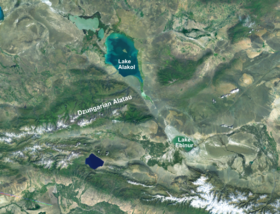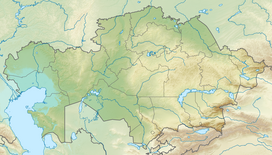
Back Джунгарски врати Bulgarian Dzungarian Gate CEB Džungarská brána Czech Dsungarische Pforte German Puerta de Zungaria Spanish Dzungariako Atea Basque Džungarian portti Finnish Col d'Alataw French Porta de Zungaria Galician Ջունգարական դարպասներ Armenian
| Dzungarian Gate | |
|---|---|
| Alatao Pass | |
 Satellite photograph of the Dzungarian Gate, the pale, fault-lined valley running between Lake Alakol and Lake Ebinur through the Dzungarian Alatau mountain range. | |
| Location | China–Kazakhstan border |
| Range | Dzungarian Alatau |
| Coordinates | 45°21′N 82°25′E / 45.35°N 82.42°E |
 | |
| Dzungarian Gate | |||||||
|---|---|---|---|---|---|---|---|
| Chinese name | |||||||
| Traditional Chinese | 阿拉山口 | ||||||
| Simplified Chinese | 阿拉山口 | ||||||
| Literal meaning | Alatao Pass | ||||||
| |||||||
| Kazakh name | |||||||
| Kazakh | Жетісу қақпасы, Жоңғар қақпасы Jetısu qaqpasy, Joñğar qaqpasy | ||||||
| Mongolian name | |||||||
| Mongolian | Зүүнгарын хаалга Züüngariin khaalga | ||||||

The Dzungarian Gate, also known as the Altai Gap, is a geographically and historically significant mountain pass between China and Central Asia.[1] It has been described as the "one and only gateway in the mountain-wall which stretches from Manchuria to Afghanistan, over a distance of three thousand miles [4,800 km]."[2] Given its association with details in a story related by Herodotus, it has been linked to the location of legendary Hyperborea.[3]
The Dzungarian Gate (Chinese: 阿拉山口; pinyin: Ālā Shānkǒu; Kazakh: Жетісу қақпасы Jetısu qaqpasy or Жоңғар қақпасы Joñğar qaqpasy) is a straight valley which penetrates the Dzungarian Alatau mountain range along the border between Kazakhstan and Xinjiang, China.[4] It currently serves as a railway corridor between China and the West. Historically, it has been noted as a convenient pass suitable for riders on horseback between the western Eurasian steppe and lands further east, and for its fierce and almost constant winds.[5]
In his Histories, Herodotus relates travelers' reports of a land in the northeast where griffins guard gold and where the North Wind issues from a mountain cave. Given the parallels between Herodotus' story and modern reports,[6][7] scholars such as Carl Ruck,[8] J.D.P. Bolton[9] and Ildikó Lehtinen[10] have speculated on a connection between the Dzungarian Gate and the home of Boreas, the North Wind of Greek mythology. With legend describing the people who live on the other side of this home of the North Wind as a peaceful, civilized people who eat grain and live by the sea.
Its gateway status is now supplanted by the new gateway city of Khorgas.
- ^ MacFarquhar, Roderick; Fairbank, John K.; Twitchett, Denis (1991). Cambridge History of China: The People's Republic, Part 2 : Revolutions Within the Chinese Revolution, 1966–1982. Cambridge University Press. p. 266. ISBN 9780521243377.
- ^ Three thousand miles equal to about 4,800 kilometers. The exact distance from where to where to which Carruthers is referring is unclear. Carruthers, Douglas. Unknown Mongolia: A Record of Travel and Exploration in North-West Mongolia. p. 415.
- ^ Mallory, J. P.; Mair, Victor H. (2000). The Tarim Mummies: Ancient China and the Mystery of the Earliest Peoples from the West. Thames & Hudson. p. 44. ISBN 0-500-05101-1.
- ^ "Astronaut Photo STS085-503-61 KAZAKHSTAN". eol.jsc.nasa.gov. Earth Science and Remote Sensing Unit, NASA Johnson Space Center. August 1997.
- ^ Douglas Carruthers, Unknown Mongolia: A Record of Travel and Exploration in North-West Mongolia p415
- ^ Adrienne Mayor, Peter Dodson, The first fossil hunters: paleontology in Greek and Roman times, Princeton University Press, 2001, p. 27 (See also map, p. 28)
- ^ "Considering that Pliny, referring to Aristeas, says that the Arimaspeans lived very near 'the Earth's gate' and the 'cave of the North Wind', we must seek them somewhere near the Dzungarian Gate, and not in the Urals or Tibet." Ildikó Lehtinen, Traces of the Central Asian culture in the North: Finnish-Soviet Joint Scientific Symposium held in Hanasaari, Espoo, 14–21 January 1985 Suomalais-ugrilainen Seura, 1986 p180
- ^ Wasson, R.G.; Kramrisch, Stella; Ott, Jonathan; et al. (1986), Persephone's Quest - Entheogens and the origins of Religion, Yale University Press, pp. 227–230, ISBN 0-300-05266-9
- ^ Bolton, J.D.P. (1962). Aristeas of Proconnesus
- ^ "Considering that Pliny, referring to Aristeas, says that the Arimaspeans lived very near 'the Earth's gate' and the 'cave of the North Wind', we must seek them somewhere near the Dzungarian Gate, and not in the Urals or Tibet." Ildikó Lehtinen, Traces of the Central Asian culture in the North: Finnish-Soviet Joint Scientific Symposium held in Hanasaari, Espoo, pp. 14–21 January 1985 Suomalais-ugrilainen Seura, 1986 p180

